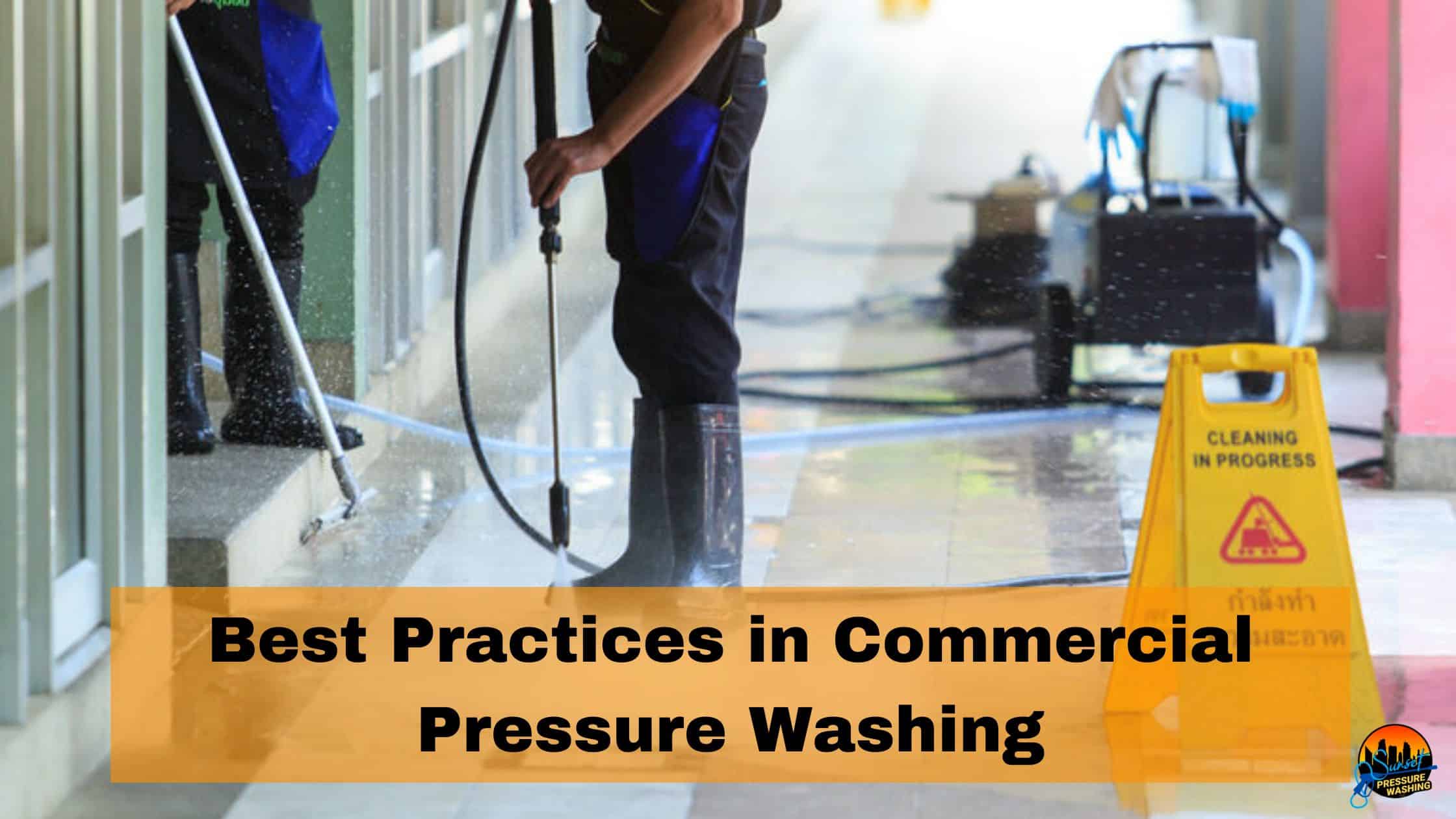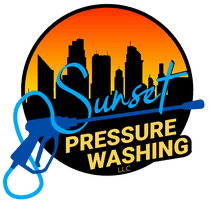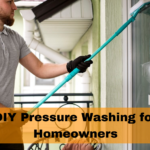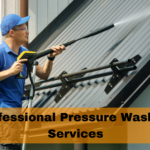
Best Practices in Commercial Pressure Washing
Commercial pressure washing is an essential service for maintaining the cleanliness and aesthetic appeal of business premises. This blog post covers the best practices in commercial pressure washing to ensure efficient, safe, and effective cleaning, followed by an introduction to our top-notch services.
Understand the Basics of Pressure Washing
Pressure washing, also known as power washing, involves using high-pressure water spray to remove dirt, grime, mold, algae, and other pollutants from various surfaces. This method is a popular choice for cleaning buildings, vehicles, and outdoor surfaces like sidewalks, patios, and driveways. Understanding the basic principles and methods of pressure washing is crucial for effective cleaning and maintaining the integrity of the surfaces being cleaned.
Key Components of a Pressure Washer
A pressure washer consists of several key components:
- Pump: The heart of the pressure washer, which generates the high-pressure water spray.
- Motor or Engine: Powers the pump; can be electric or gasoline-powered.
- Hose: Transports the water from the pump to the nozzle.
- Nozzle: Controls the spray pattern and intensity. Different nozzles are suited for different cleaning tasks.
- Water Supply: Typically connected to a standard garden hose, which provides the water that will be pressurized.
How Pressure Washing Works
Pressure washers use a pump to force water through a narrow nozzle, creating a powerful stream that can blast away accumulated dirt and other materials without the need for harsh chemicals. The effectiveness of pressure washing comes from the combination of high water pressure and the volume of water used (measured in gallons per minute or GPM).
Choosing the Right Pressure Washer
The choice of pressure washer depends on the nature of the task:
- Light-Duty Pressure Washers: Ideal for small tasks like cleaning bicycles, small patios, and garden furniture. These units typically operate at up to 1900 PSI.
- Medium-Duty Pressure Washers: Suitable for larger areas like fences, decks, and driveways. These machines generally range from 2000 to 2800 PSI.
- Heavy-Duty Pressure Washers: Best for large-scale commercial jobs like cleaning large buildings, concrete paths, and robust stains. These washers operate above 2900 PSI.
Considerations Before Starting
Before starting a pressure washing project, consider the following:
- Surface Material: Not all materials can withstand the force of high-pressure water. It’s important to choose the correct pressure setting and nozzle to avoid damaging surfaces.
- Type of Dirt: Some surfaces may only need water for cleaning, while others might require specialized cleaning solutions to break down oil, grease, or biological growth.
- Environmental Impact: Be mindful of where the water and potential pollutants are going. Contain runoff where necessary to prevent pollutants from entering storm drains or waterways.
Safety First
Pressure washers can be dangerous if not used correctly. The high-pressure water can cause serious injuries and damage to surfaces if mishandled. Always wear protective gear, such as safety goggles, gloves, and ear protection, and never point the pressure washer at yourself, other people, or pets.
Choose the Right Equipment
Selecting the right pressure washing equipment is crucial for achieving effective results without damaging property. The right equipment not only improves cleaning efficiency but also ensures safety and longevity of your pressure washer. Here are essential factors to consider when choosing the right equipment for your pressure washing needs:
Understand Pressure Washer Types
Pressure washers are categorized based on the type of power source they use:
- Electric Pressure Washers: Ideal for light to medium-duty tasks. They are quieter, lighter, and require less maintenance than gas models. Perfect for residential use, including cleaning decks, patios, and furniture.
- Gas Pressure Washers: Suited for medium to heavy-duty jobs. These are more powerful and portable since they don’t require a power outlet but are noisier and emit fumes, making them suitable for outdoor use.
Consider PSI and GPM Ratings
- PSI (Pounds per Square Inch): This measures the pressure of water, which helps to break down the dirt and grime. Residential models typically range from 1300 to 2500 PSI, while commercial models may exceed 3000 PSI
- GPM (Gallons Per Minute): This measures the flow rate of water. Higher GPM means more cleaning power, enabling you to cover larger areas in less time.
A balance between PSI and GPM is essential for effective cleaning—too much pressure can damage surfaces, while too little may not be effective.
Select the Right Nozzles and Attachments
Nozzles control the angle and intensity of the water spray. Common nozzle types include:
- 0-degree: Produces a concentrated jet of water for tough stains.
- 15-degree: Ideal for stripping paint and cleaning concrete.
- 25-degree: Good for general cleaning on decks, patios, and siding.
- 40-degree: Provides a wider spray for gentle cleaning on windows and cars.
- Soap nozzle: Used for applying detergents and cleaning solutions.
Attachments such as surface cleaners, extension wands, and gutter cleaners enhance the functionality and reach of your pressure washer.
Consider Portability and Storage
The size and weight of the pressure washer impact its portability and storage. If you need to move the pressure washer across large properties or different locations, consider units with robust wheels and handles. Also, think about storage space when choosing the size of the pressure washer.
Evaluate Ease of Use
Features like adjustable pressure settings, easy-start engines, and onboard storage for nozzles and hoses can make a pressure washer more user-friendly. Electric models with instant start-stop systems are particularly convenient as they operate only when the trigger is pressed, saving energy and reducing noise.
Maintenance and Durability
Choose pressure washers that are easy to maintain and built to last. Stainless steel and brass components are more durable than plastic. Regular maintenance such as checking hoses for leaks and changing engine oil (for gas models) extends the life of the equipment.
Environmental Considerations
For businesses and environmentally conscious users, consider models that offer eco-friendly features such as water conservation technologies or systems designed to reduce chemical use.
Use the Correct Cleaning Agents
When it comes to pressure washing, the choice of cleaning agents can significantly impact the effectiveness of the cleaning process, as well as the safety of your surfaces and the environment. Using the correct cleaning agents not only enhances the cleaning power of your pressure washer but also ensures that you are complying with environmental regulations and protecting delicate surfaces from damage. Here’s how to select and use the right cleaning agents for your pressure washing tasks.
Identify the Surface Material
Different materials require different types of cleaners. What works on concrete may be too harsh for wood or could damage paint on a vehicle. Common surface materials include:
- Concrete: Needs strong degreasers and cleaners to remove oil, grease, and deep-seated dirt.
- Wood: Requires gentler, more neutral cleaners to prevent damage to the fibers and any protective finishes.
- Vinyl and Aluminum Siding: Benefits from specialized detergents that remove mildew, algae, and dirt without discoloring or damaging the surface.
- Vehicles: Should be cleaned with automotive-specific soaps that will not strip wax or damage paint.
Consider the Type of Dirt
The type of dirt or stain you are dealing with will also dictate the type of cleaning agent required:
- Grease and Oil: Require solvents or degreasers that can break down oily substances.
- Mold and Mildew: Need cleaners with fungicides or mildewcides to effectively remove and prevent regrowth.
- General Dirt and Debris: Often cleaned effectively with general-purpose cleaners or even just plain water for lightly soiled surfaces.
Choose Environmentally Friendly Options
Whenever possible, opt for biodegradable, non-toxic cleaners that are safe for the environment. Many modern cleaning solutions are designed to be eco-friendly and are just as effective as traditional chemicals. Look for products that:
- Are labeled as “non-toxic,” “biodegradable,” or “eco-friendly.”
- Do not contain phosphates, solvents, or other harsh chemicals that can harm local wildlife or water sources.
- Are safe for use around plants and animals if you’re working outdoors.
Follow Manufacturer Recommendations
Always check the recommendations from your pressure washer’s manufacturer for compatible cleaning solutions. Using the wrong type of cleaner can not only be ineffective but might also damage the pressure washer itself or void any warranties.
Dilution and Application
Proper dilution of cleaning agents is crucial. Using too concentrated a solution can damage the surface being cleaned and pose environmental hazards. Most commercial cleaning agents come with instructions for dilution ratios which should be followed strictly.
- Pre-treat Stains: For tough stains, apply the cleaning solution directly to the area and allow it to sit for several minutes before washing.
- Use a Low-Pressure Nozzle for Application: Apply cleaning solutions using a lower pressure setting or a specific soap nozzle to avoid splashing concentrated cleaner.
Handle and Store Safely
Handling and storing cleaning agents safely is vital to protect yourself and others. Always wear protective gloves and eyewear when handling chemicals, and ensure that all containers are securely sealed and stored in a cool, dry place away from children and pets.
Prioritize Safety Measures
Safety is paramount in pressure washing due to the high-pressure water streams that can cause serious injuries and property damage if mishandled. Ensuring safety not only protects operators but also the general public and the environment. Here are key safety measures to prioritize when conducting pressure washing operations.
Wear Protective Gear
Always wear appropriate personal protective equipment (PPE) to guard against the inherent risks of pressure washing. Essential gear includes:
- Safety Glasses or Goggles: Protects eyes from flying debris and chemical splashes.
- Waterproof Gloves: Provides grip and protects hands from chemicals and high-pressure water.
- Ear Protection: Necessary if using gas-powered pressure washers, which can generate significant noise.
- Sturdy Footwear: Wear non-slip, waterproof boots to prevent slips and falls.
Check Equipment Before Use
Before starting your pressure washer, perform a thorough check of the equipment to ensure everything is in good working order. This includes:
- Inspecting hoses for any signs of wear or damage.
- Checking connections and fittings to ensure they are secure and leak-free.
- Ensuring the washer’s engine or motor is functioning correctly.
- Verifying that safety features, like the trigger lock and pressure relief valves, are operational.
Be Aware of Your Surroundings
Pressure washing can easily affect more than just the surface you intend to clean. It is essential to be aware of your surroundings:
- Clear the Area: Remove or cover any objects that could be damaged by water or debris, such as outdoor furniture, vehicles, or landscaping.
- Protect Bystanders: Ensure that no people or pets are in the vicinity who could be accidentally harmed by the high-pressure spray.
- Watch for Electrical Hazards: Be cautious around electrical outlets, fixtures, and power lines. Use a GFCI (Ground Fault Circuit Interrupter) plug to prevent electrical shocks.
Use Proper Techniques
Improper handling or incorrect techniques can lead to accidents. When using a pressure washer:
- Never Point the Nozzle at Anyone: The stream from a pressure washer can cause serious injuries.
- Maintain a Firm Grip and Stance: Hold the pressure washer with both hands when operating and stand in a stable position to handle the force of the water.
- Avoid Ladders: The recoil from a pressure washer can throw you off balance. Instead, use extension wands for high areas.
Handle Chemicals Safely
If you’re using cleaning agents, it’s important to handle them safely:
- Read Labels and MSDS: Always read the product label and Material Safety Data Sheet (MSDS) for proper handling and emergency procedures.
- Use Proper Containers: Store chemicals in containers designed for them to prevent leaks and chemical reactions.
Properly Manage Water and Runoff
The water runoff from pressure washing can contain harmful chemicals and pollutants. Manage this properly by:
- Using containment methods to collect runoff water.
- Preventing runoff from entering storm drains.
- Following local regulations on water disposal, especially when using chemicals.
Training and Awareness
Ensure that everyone who uses a pressure washer is properly trained. They should understand how to operate the equipment safely, be aware of the potential risks, and know how to handle emergency situations.
Understand Surface Types
When it comes to pressure washing, one size does not fit all. Different materials require specific care to avoid damage while effectively removing dirt, stains, and other residues. Understanding the types of surfaces you are cleaning is critical to selecting the right equipment settings, cleaning agents, and techniques. Here’s a guide to understanding and treating various surface types with pressure washing.
1. Concrete
Concrete is one of the most common surfaces cleaned with pressure washers due to its durability. It can withstand high pressures, making it ideal for removing oil stains, grease, and mildew. However, older concrete may be more porous and susceptible to damage:
- Recommended PSI: 3000 to 4000 PSI for heavily soiled areas.
- Cleaning Solutions: Degreasers and cleaners formulated for concrete can enhance cleaning effectiveness.
- Technique: Use a rotating or turbo nozzle to efficiently tackle tough stains.
2. Wood
Wood surfaces, such as decks and fences, require a gentle approach to avoid stripping away protective finishes or damaging the wood itself:
- Recommended PSI: 500 to 1200 PSI, depending on the wood’s hardness and age.
- Cleaning Solutions: Use a cleaner specifically designed for wood that will also treat and protect against mold and mildew.
- Technique: Spray along the grain of the wood and keep the nozzle moving to prevent etching.
3. Brick and Stone
Brick and stone are robust materials but have mortar that can be dislodged by too much pressure:
- Recommended PSI: 1000 to 1500 PSI.
- Cleaning Solutions: Detergents made for brick and stone can help remove efflorescence (white salt-like deposits) and grime.
- Technique: Use a wide-angle spray pattern and avoid direct spraying into the joints to protect the mortar.
4. Vinyl Siding
Vinyl siding cleans well with pressure washing but can be susceptible to warping under high heat or pressure:
- Recommended PSI: 1300 to 1600 PSI.
- Cleaning Solutions: Mildew-resistant cleaners are best, especially in humid climates.
- Technique: Spray at an angle to prevent water from getting behind the siding, which could cause damage and mold growth.
5. Asphalt
Cleaning asphalt, like driveways, requires care to prevent stripping away small stones from the asphalt:
- Recommended PSI: 2500 to 3000 PSI.
- Cleaning Solutions: Tar-specific cleaners can remove vehicle fluids and tire marks.
- Technique: Use a medium spray pattern to avoid dislodging the asphalt.
6. Metal
Metal surfaces, such as machinery or metal siding, can handle high pressure but are prone to rusting if not properly dried:
- Recommended PSI: 1500 to 2500 PSI.
- Cleaning Solutions: Use rust-inhibitors if rust is a concern.
- Technique: Rinse thoroughly to prevent streaking and remove all cleaning agents to avoid corrosion.
7. Stucco
Stucco is a delicate surface that can be easily damaged by high pressure:
- Recommended PSI: Under 1500 PSI.
- Cleaning Solutions: Use gentle cleaners designed not to damage the paint or surface.
- Technique: Use a fan spray setting and hold the nozzle at least two feet away from the surface.
8. Roofs
Cleaning roofs requires special consideration to avoid damaging shingles or tiles:
- Recommended PSI: Generally under 1000 PSI.
- Cleaning Solutions: Algae and moss removal products.
- Technique: Often best cleaned with soft washing techniques rather than high-pressure washing.
Pre-Cleaning Preparation
Proper preparation is key to maximizing the efficiency and safety of pressure washing while protecting the property and its surroundings. Before starting the pressure washing process, it’s important to take several preparatory steps to ensure a smooth and effective cleaning. Here are essential tips on how to prepare for a pressure washing session.
Inspect the Area
Begin with a thorough inspection of the area to be cleaned. Look for any damage that may need to be repaired before cleaning, such as cracked siding, loose bricks, or damaged seals around windows. Addressing these issues beforehand can prevent water from penetrating and causing further damage.
Clear the Work Area
Remove any obstacles that could hinder the cleaning process or potentially become hazards:
- Move vehicles, outdoor furniture, and portable plant containers out of the area.
- Pick up loose items such as toys, garden tools, and decorations that might be displaced by the high-pressure water stream.
Protect Delicate Features
Cover and protect vulnerable features of the area:
- Use plastic sheeting or drop cloths to cover plants, landscaping, outdoor lighting, and electrical outlets to protect them from water and cleaning chemicals.=
- Close all windows and doors, and seal any openings where water might enter.
Pre-Treat Stains
For tough stains such as oil on driveways or mildew on siding, pre-treating the area can improve cleaning effectiveness:
Apply a detergent or a specialized cleaning solution to stubborn stains and let it sit for several minutes, according to the product’s instructions, before washing.
Inform and Caution Others
Safety for all should be a priority
- Notify neighbors and passersby of the cleaning activity, especially in commercial areas, to prevent accidental exposure to high-pressure water or chemicals.
- Set up warning signs or barriers if necessary to keep people at a safe distance.
Check Weather Conditions
Weather can significantly impact the pressure washing process:
- Ideal conditions are mild temperatures with overcast skies to prevent quick drying, which can lead to uneven cleaning.
- Avoid pressure washing in high winds, which can spread cleaners away from target surfaces and into areas where they aren’t wanted.
- Ensure that no rain is forecasted which could dilute the cleaning agents and affect their effectiveness.
Prepare the Equipment
Ensure that the pressure washer and all accessories are in good working order:
- Connect hoses and fittings securely to avoid leaks.
- Select the appropriate nozzles and attachments for the job at hand, based on the type of surface and level of dirt.
- Fill the pressure washer with fuel if it’s gas-powered or ensure access to an electrical outlet if it’s electric.
Safety Gear
Before starting, make sure all operators are equipped with appropriate safety gear:
Wear protective goggles, gloves, ear protection (if needed), and non-slip boots to protect against flying debris, chemicals, and the force of the water.
Efficient Cleaning Techniques
Achieving optimal results in pressure washing is not just about having the right equipment; it’s also about using efficient cleaning techniques. These methods not only enhance the effectiveness of the cleaning process but also ensure that you’re completing the task safely and economically. Here are some essential techniques to employ during pressure washing for efficient and effective cleaning.
Choose the Correct Nozzle and Pressure Setting
The nozzle you choose and the pressure setting you use can greatly influence the outcome. Each nozzle type has a specific purpose and is suitable for different types of cleaning tasks:
- 0-degree nozzle: Delivers a pinpoint, high-pressure spray for tough stains and debris on concrete and metal.
- 15-degree nozzle: Ideal for stripping paint, cleaning concrete, and preparing surfaces for refinishing.
- 25-degree nozzle: Perfect for general cleaning on decks, patios, and siding.
- 40-degree nozzle: Best for delicate surfaces and light cleaning, such as windows and vehicles.
- Soap nozzle: Used specifically for applying detergents and cleaning solutions at low pressure.
Using the right pressure setting is crucial to avoid damage to the surface being cleaned. Always start with the lowest effective pressure and increase as needed.
Pre-Treat the Area with Cleaning Solutions
For areas heavily soiled with oil, grease, or biological growth, pre-treating the surface with a suitable cleaning solution can improve the cleaning efficiency:
- Apply the cleaning agent and allow it to dwell on the surface for several minutes.
- Do not let the solution dry out, as this can make the cleaning process more difficult.
Use Efficient Sweeping Motions
When using the pressure washer, employ sweeping motions to clean the surface efficiently:
- Hold the nozzle at a consistent distance from the surface—usually 12 to 18 inches—to ensure even cleaning.
- Sweep the water stream back and forth across the surface in a controlled manner.
- Overlap each stroke slightly to ensure no spots are missed.
Maintain a Steady Pace
Move the spray wand at a steady pace to avoid lingering too long in one spot, which can damage the surface. The right speed depends on the pressure setting and the type of surface being cleaned:
- A slower pace might be necessary for more stubborn stains.
- A quicker pass is adequate for lighter dirt or when rinsing the surface.
Clean from Top to Bottom
For vertical surfaces like walls and siding:
- Start from the top and work your way down to ensure that dirt and soap flow down from the cleaned areas.
- This technique prevents streaking and re-depositing of dirt on cleaned areas.
Manage Overlapping Areas
When cleaning large surfaces, manage overlaps carefully:
- Overlap each pass by about six inches to ensure complete coverage without leaving any lines or streaks.
- This technique is crucial for avoiding visible lines that can occur when the edges of the spray pattern meet dry surface.
Rinse Thoroughly
After cleaning, thoroughly rinse the surface to remove any residual detergent or loosened dirt:
Use a higher pressure setting if necessary, but switch to a wider nozzle to safely and effectively rinse away residues.
Regularly Check for Damage
Periodically stop and check the area you’ve cleaned for any signs of damage:
If damage is occurring, adjust your technique, such as moving the nozzle further from the surface or reducing the pressure.
Post-Cleaning Inspection and Maintenance
After completing a pressure washing job, it’s important to conduct a thorough post-cleaning inspection and engage in proper maintenance practices. These steps ensure that the cleaned surfaces are in good condition and that the equipment will remain reliable for future use. Here’s a comprehensive guide to conducting post-cleaning inspection and maintenance.
Inspect Cleaned Surfaces
Once the cleaning process is complete, carefully inspect the areas that have been washed to ensure they are thoroughly cleaned and free of damage:
- Check for Uniformity: Make sure there are no streaks or patches that may have been missed or unevenly cleaned.
- Look for Damage: Examine the surfaces for any signs of damage caused by the pressure washing, such as etching, stripping of paint, or loosening of materials.
- Identify Any Remaining Stains: Spot any stains or areas that might need a second cleaning or different approach.
Perform Necessary Touch-Ups
If any areas require additional attention, address these promptly:
- Re-clean Tough Stains: Some stains might need a second pass, possibly with a different nozzle or pressure setting.
- Repair Damage: If any minor damage is discovered, such as chipped paint or dislodged fillers, plan for repairs to maintain the integrity and appearance of the surface.
Clean and Store Equipment Properly
Proper maintenance of your pressure washer and accessories is critical for extending their lifespan and ensuring they are ready for next use:
- Rinse the Equipment: Flush out any detergent or debris from the pressure washer system, especially if you’ve used cleaning chemicals.
- Check for Wear and Tear: Inspect hoses, nozzles, and fittings for any signs of damage or wear. Replace any faulty parts immediately.
- Drain Water: Ensure all water is drained from the machine to prevent freezing and corrosion, which is particularly important in colder climates.
- Store Accessories: Keep all nozzles, hoses, and attachments in a clean, dry place. Organize them neatly to avoid tangles and damage.
Follow Manufacturer’s Guidelines for Maintenance
Consult the user manual for specific maintenance recommendations for your pressure washer:
- Regular Check-Ups: Perform regular check-ups as recommended by the manufacturer, including checking oil levels, air filters, and spark plugs (for gas models).
- Scheduled Servicing: If applicable, schedule professional servicing to keep mechanical parts in optimal condition.
Record Keeping
Maintain a log of cleaning activities, including areas cleaned, techniques used, and any issues encountered:
- Document Equipment Use: Keep track of how often the equipment is used and any maintenance actions taken. This helps in planning preventive maintenance and replacements.
- Note Cleaning Results: Record the effectiveness of different techniques and solutions on various surfaces for future reference. This can be incredibly helpful for achieving consistent results and improving efficiency over time.
Review Safety Procedures
Post-operation is a good time to review the safety measures that were followed and note any areas for improvement:
- Assess Safety Gear Usage: Ensure all safety protocols were adhered to and consider if additional measures are needed for future tasks.
- Evaluate Environmental Safety Compliance: Confirm that all environmental regulations were followed, especially regarding chemical use and water runoff.
Waste Water Management
Effective waste water management is crucial in pressure washing operations, not only for environmental protection but also for compliance with local regulations. The runoff from pressure washing can contain pollutants like oils, grease, chemicals, and dirt, which can harm aquatic ecosystems and contaminate soil if not properly handled. Here’s a detailed guide on managing waste water generated during pressure washing activities.
Understand Local Regulations
Before starting any pressure washing project, familiarize yourself with local, state, and federal regulations regarding waste water disposal:
- Permits: Some areas require permits for discharging pressure washing waste water, especially when using chemicals.
- Disposal Methods: Regulations may dictate where and how you can dispose of waste water, such as prohibiting discharge into storm drains or requiring treatment before disposal.
Prevent Runoff
Minimizing runoff not only helps in managing waste water but also reduces the potential for environmental harm:
- Use Containment Mats: Place mats to collect water in areas where waste water can pose a risk, such as driveways or near storm drains.
- Employ Berms or Barriers: These can be used to redirect or contain water flow away from sensitive areas.
Collect and Contain Waste Water
In scenarios where water runoff could be problematic, use systems to collect and contain the water:
- Vacuum Recovery Systems: These systems suck up water as it is used, preventing it from entering the environment.
- Portable Containment Tanks: Useful for larger jobs where significant amounts of water are generated, allowing for controlled disposal.
Treat Waste Water
If your pressure washing involves harmful substances, treating the water before disposal is essential:
- Filtration Systems: Remove solid particulates from the water.
- Oil-Water Separators: Used to separate and remove oil from water, especially important in automotive or industrial cleaning.
- pH Neutralization: Some jurisdictions require that waste water pH be neutralized before disposal.
Reuse and Recycle Water
Consider systems that allow you to reuse water, which can be both cost-effective and environmentally friendly:
- Reclamation Systems: These systems clean and recycle the water for repeated use in pressure washing, reducing the total amount of water used and minimizing waste.
- Rainwater Harvesting: Collect rainwater for use in pressure washing, which reduces demand on municipal water systems and lowers the environmental footprint.
Proper Disposal of Waste Water
Ensure that all waste water is disposed of according to local regulations:
- Sewer Systems: In many locations, it is permissible to discharge waste water into sanitary sewers but not into storm sewers.
- Approved Disposal Sites: Some areas may have designated facilities for the disposal of contaminated water.
Educate and Train Staff
Make sure that all personnel involved in pressure washing are aware of and trained in effective waste water management practices:
- Regular Training: Conduct training sessions to update team members on the latest regulations and technologies in waste water management.
- Best Practices: Encourage practices that reduce water usage and prevent pollution.
Document Procedures and Compliance
Keep records of how waste water was managed and disposed of for each job:
- Documentation: Maintain logs that include details like the amount of water used, the method of waste water management employed, and disposal records.=
- Compliance Checks: Regularly review practices to ensure they remain in compliance with changing environmental regulations.
Continuous Learning and Adaptation
In the rapidly evolving field of pressure washing, continuous learning and adaptation are key to staying competitive and maintaining high standards of service. Advancements in technology, changes in environmental regulations, and shifting customer expectations demand that professionals in the industry keep up-to-date. Here’s how you can foster a culture of continuous learning and adaptation in your pressure washing business.
Stay Informed About Industry Trends
Keeping abreast of industry trends is crucial. This includes new technologies in equipment, eco-friendly cleaning solutions, and innovative cleaning techniques:
- Trade Shows and Expos: Attend industry-related events to see the latest equipment and products in action.
- Subscriptions to Trade Journals: Subscribe to relevant publications to receive updates and insights into industry trends and best practices.
- Online Forums and Groups: Participate in online communities where professionals discuss challenges, solutions, and ideas.
Upgrade Technology and Equipment
As new technologies become available, they can often improve efficiency, reduce costs, and enhance safety. Investing in the latest equipment can provide a competitive edge:
- Eco-Friendly Machines: Look for pressure washers that use less water and energy or that have built-in water recycling systems.
- Advanced Nozzles and Attachments: These can increase cleaning efficiency and allow for more versatile services.
- Automation and Robotics: Emerging technologies that can handle repetitive tasks or operate in hazardous conditions without human intervention.
Regular Training and Certification
Ongoing education is essential to ensure that all team members are skilled in using new equipment and are up-to-date with the latest cleaning techniques and safety protocols:
- Certification Programs: Enroll staff in courses that offer certifications from recognized industry organizations.
- In-house Training Sessions: Regularly schedule training sessions to review procedures, introduce new methods, and reinforce best practices.
- Safety Training: Keep safety trainings current with the latest health and safety guidelines.
Adapt to Environmental Regulations
Environmental regulations can change frequently, and adapting to these changes is essential for legal compliance and environmental protection:
- Stay Updated on Legislation: Monitor changes in local, state, and federal environmental laws that impact how you manage chemicals and waste water.
- Implement Sustainable Practices: Adapt business practices to embrace more sustainable methods, such as using biodegradable cleaning agents and improving waste water management systems.
Solicit Feedback and Learn from Experience
Feedback from clients can provide invaluable insights into areas needing improvement and help identify new opportunities:
- Customer Surveys: Regularly ask for feedback on the quality of service and areas for improvement.
- Review and Debrief: After each job, conduct a review session with your team to discuss what went well and what could be better next time.
Foster a Culture of Innovation
Encourage a workplace environment where employees are motivated to come up with innovative solutions and improvements:
- Idea Sharing Sessions: Hold regular meetings where employees can suggest new ideas without fear of criticism.
- Reward Innovation: Recognize and reward efforts to improve processes, whether through cost savings, improved safety, or enhanced customer satisfaction.
Monitor Competitor Activities
Understanding how competitors are adapting to changes in the industry can provide critical insights and help you remain competitive:
- Market Analysis: Keep an eye on how competitors are marketing their services and adjusting to customer needs.
- Competitive Benchmarking: Compare your business practices against those of competitors to identify areas where you can improve.
Introducing Our Expert Pressure Washing Services
As we conclude our exploration of best practices in commercial pressure washing, it’s clear that achieving pristine results goes beyond just using the right equipment it requires expertise, precision, and a commitment to environmental stewardship. This is where our expert pressure washing services come into play. At Sunset Pressure Washing, we embody these principles in every project we undertake, ensuring that your property not only shines but is treated with the utmost care and professionalism. Our team is equipped with the latest technology and trained in the most effective techniques to handle any cleaning challenge.
Ready to see the difference that professional pressure washing can make to the appearance and longevity of your property? With commercial pressure washing services in Charleston SC, Greenwood SC, Laurens SC, and other parts of South and North Carolina, Sunset Pressure Washing delivers safe, efficient, and environmentally responsible cleaning solutions. Contact us today to schedule a consultation or service appointment. Let us help you restore your property’s beauty and tailor our services to meet your specific needs. Elevate your property’s curb appeal with Sunset Pressure Washing, where quality meets reliability and satisfaction is guaranteed.






